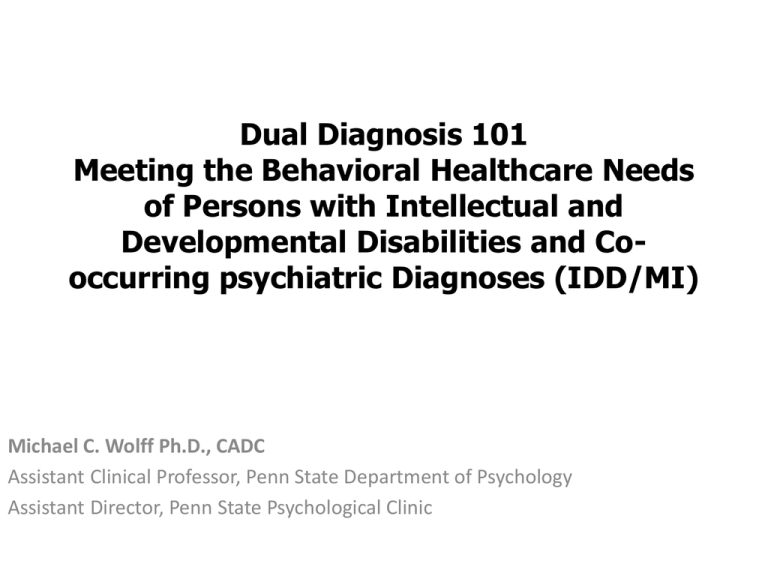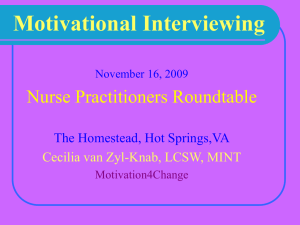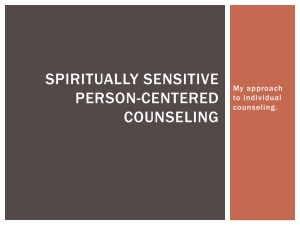Client - bharp
advertisement

Dual Diagnosis 101 Meeting the Behavioral Healthcare Needs of Persons with Intellectual and Developmental Disabilities and Cooccurring psychiatric Diagnoses (IDD/MI) Michael C. Wolff Ph.D., CADC Assistant Clinical Professor, Penn State Department of Psychology Assistant Director, Penn State Psychological Clinic Goals for today • Continue to highlight best practice guidelines with respect to working with dual diagnosis populations • Additional treatment/support strategies – best practice for responding to resistance and difficult behaviors, encouraging services, accomplishing goals, etc. • Examine staff contributions– working with difficult clients and working to be the best of our ability, and in a less stressed manner • Putting it all together. Use of video clips and vignettes to facilitate understanding My background • Substance Abuse……not that kind • Community mental health (children and youth/probation) • Psychotherapy – Adults and Children + Families • Consultation with dual diagnosis populations • Convergence of ideas…. Some of Mike’s Pet Peeves…. • Meetings where clients are present and participants are not speaking directly to the client, but talking as if the client is not present. • Using terms like “Manipulative” or “Attention Seeking” or “Acting like a baby” or “Scheming” or “Just to make me mad” to describe function of a behavior • Infantilizing clients; referring to (or talking to) adults as children or kids • Referring to a challenging behavior as BEHAVIORAL not PSYCHOLOGICAL…it’s really a false dichotomy No need to be a diagnostician! • Dimensional far outweighs Categorical – Impulsivity/behavioral control – Agitation/irritability – Processing deficits (sensory) – Social challenges – Mood regulation – Thought disturbance – Behavioral control – Substance induced impairment In the field – Anxiety • Person experiencing a panic attack • Hypervigilance, obsessions, and compulsions can look like noncompliance • Can appear reckless In the field-Depression • • • • Can often take the form of extreme irritability Apathy and lack of cooperation Hopelessness Difficulty concentrating, answering questions and focusing • Video 2:00 Bi-Polar in the field • Dealing with a manic individual is very challenging • Unable to sustain a reciprocal conversation • Sleep disturbances • High energy, inability to regulate mood and behavior • Engaging in many high risk behaviors including substance use, sexual promiscuity, and at times illegal activities Schizophrenia in the field • • • • Disorganized Scared and confused Paranoia can lead to aggression very quickly Actively psychotic individuals are very difficult to manage and require a very gentle approach Autism in the field….. • Non responsive, limited eye contact (can be mistaken for suspicious behavior) • Irritable and confused • Unable to follow commands (can be mistaken for non-compliance, non-cooperative) • Highly sensitive to sensory input (noise, touch, surroundings) hyper/hypo • Can become violent due to inability to adequately/accurately perceive threat Video clip (16.45) Personality Disorders • Enduring pattern of inner experiences and behavior, which deviates markedly from the norm • Involves cognition, affectivity, interpersonal functioning, impulse control • Leads to clinically significant distress • Stable, long duration (patterns tracked back to adolescence or early adulthood) The Clusters Cluster A Odd/Eccentric Paranoid: Distrust and suspicious of others Schizoid: Detachment from social relationships and restricted range of emotional expression Schizotypal: Lack of capacity for close relationships, cognitive distortions and eccentric behavior Cluster C Anxious/Fearful Cluster B Dramatic/Erratic Antisocial: Disregard for and violation Of the rights of others Borderline: Instability of interpersonal relationships, self image, and affect, and marked impulsivity Histrionic: Excessive emotionally and attention seeking Narcissistic: Grandiosity, need for admiration and lack of empathy Avoidant: Social inhibition, feelings of inadequacy, and hypersensitivity to negative evaluation Dependent: Excessive need to be taken care of, submissive behavior, and fears of separation Obsessive Compulsive: Preoccupation with order, perfection, and control Two distinct interactions • http://www.youtube.com/watch?v=A8WvDJGHi4 • 17:30 What to do? • We need to be diligent in our efforts to place ourselves in the shoes of our clients • Please don’t compare their behavior to how we would handle a situation or struggle, nobody cares, really (we are all just trying to get by) • Our job is to find a way to be supportive, be empathic, yet maintain personal and professional boundaries……it’s really hard to do • But first, let’s learn to conceptualize why someone may behave the way they do Etiology Community Staff Teachers Parents & Family Biology/Health Hard Wiring Case Managers Individual Thoughts Feelings Temperament Peers Romantic Meaningful Adult Counselors Therapists Psychiatric Why does the individual behave this way? Additional Variables SES Vocational Social outlets Neighborhood Loss/Bereavement Trauma history Access to health care Quality of schools Available treatment Cultural Influences Strategies, Part 1 Strategies • Typically, behaviorally oriented strategies have greatest impact on challenging behaviors • Function of behavior (ABC’s) – Individually tailored interventions • • • • • • Incentives prior to punishment Anticipate problems before they emerge Meaningful consequences Consistency Promote emotional/behavioral control Appreciate your own contributions….. Specific Interventions Cont. Common Reasons Plans Don’t Work • Target behaviors are too broad or not operationalized (must look the same to everyone!) • Recording procedure too complicated…..data collection fatigue! • Reinforcement not powerful enough • Too much emphasis on punishment • Not enough emphasis on attention • Failure to clearly specify duties • Tendency to see plan as closed to modification • Not enough planning/oversight/training Specific Interventions Catch them doing what you want! • Be specific with your praises • Attention is a potent antecedent, it should be given frequently (positively, that is) • Praise effort over achievement (on task, working hard, coping, really thinking it through, etc.) • Avoid “good job” or “you were really good today” ….too broad and general (and implies “bad”) • Try “I liked how you _______” or “When you were ______, that seemed like you really enjoyed yourself, it was nice to see” “You worked really hard earlier when you were…” What factors contribute to the variations in challenging behaviors? Interventions Client Staff Staff contributions: We have found that… • How staff respond to challenging behaviors is determined by multiple influences/causality. – Their understanding or appreciation regarding the “function” of challenging behaviors – Their views about challenging behaviors in clients, and their views of self – Their stress level, training, experience, education – Characteristics of employing organization (i.e. quality of training, supervision, support, etc.) Video 55 sec Staff Contributions: Characteristics and styles of relating known to have positive impact on process and outcome of interactions We tend to do better when: – accurate empathy – psychological health • well-being and adjustment – thoughtful attribution • internal locus of control (what can I do differently?) – sufficient self-confidence – low reactance • staff-consumer interactions – (positive) expectancies Staff Contributions: Characteristics and styles of relating known to have negative impact on process and outcome of interactions We tend to do worse when: – highly rigid – hostile (view of others and self) – highly dominant / directive • high desire for control – – – – – – external locus of control lack self-confidence high stress levels/burnout negative expectancies of clients negative attributions/appraisals reactive – high tension with consumer Attributions and appraisal • Why do they behave this way? • They are manipulative, just to get me upset, they like doing this, they are hopeless, they are ungrateful…….how are you feeling? • Task avoidance, preference, escape, disability, hurt/pain (emotionally/physically), sensory, attention, distraction……different response? • Internal/External • Permanent/Temporary • Controllable/Uncontrollable Putting it together Challenging Behavior Attribution Burn Out Emotions Outcomes Burn Out 25 Stress and Burnout • At least some responsibility of employer • Leads to increased levels of staff illness, absenteeism, and turnover/attrition • What can you do about stress and burnout? • Increase awareness, identify sources of stress, identify outlets for assistance (internal to you, within workplace, outside of workplace) Video (Van: 6min) Stress and Burnout How do we become stressed in workplace? • Person Environment – Interaction between person and work environmentmismatch • Demand-support-control – Demand high, support/control low • Cognitive behavioral – Perception of stressors in environment (our interpretation) • Emotional overload – Exhaustion and personal accomplishment • Equity theory – Feelings and perception of inequality Modeling • What do we model with respect to our own emotional expression? • How do we cope with strong emotions and stress in general? Self efficacy • • • • Sense of agency or confidence I am able to handle this (optimism) I feel supported in my role I have necessary information to respond effectively • I am able to predict when this may or may not occur Emotional reactions • Attention (don’t do that, you know you are not supposed to do that, no no no….stop) • Avoidance (whatever, I’m scared of him/her) • Empathy, assistance, nurturance, support • Fear, anger, helplessness, apathy Burnout and exhaustion Stressful interactions can lead to… • • • • Feelings of inadequacy or impotence Compassion Fatigue Vicarious Trauma Reactions Wounded Healer Over-inflated sense of importance Countertransference Inability to “let go” of work/consumers REGARDLESS WHAT YOU CALL IT, IT CAN LEAD TO…. Avoidance (depression, loss of energy apathy) Client/work issues encroaching on personal time Interventions: Part 2 Evidence based approaches-Counseling Common Factors Motivational Interviewing PE: Emotion Focused Stages of change Evoking Working Alliance • Tasks • Goals • Bonds Arousing Resolving ambivalence Empathy • Attunement • Perspective taking • Reflection of feeling and experiences • “Maybe I should…Maybe I shouldn’t… “ • Therapist facilitates expression of both sides Be supportive….. Confrontation will not lead to development of “change talk” Accessing Empathy Processing Integrating The importance of the Working Alliance Bordin’s model: Consists of three parts Goals – Agreement on tasks – Agreement on goals – Bond Bond Tasks Motivational Interviewing and Stages of Change Maintenance Precontemplation Action Contemplation Preparation What you need to know about Motivational Interviewing… • Based on theories related to “Stages of Change” model. • Does not fit into traditional therapeutic orientation models per se, rather it can augment any approach • It is a theory for Behavior Change • Four general principles: Express empathy, develop discrepancy, roll with resistance, support self-efficacy Express empathy • Client: Everybody tells me what to do but they don’t understand how I feel • Counselor: You think people are not understanding you. • Counselor: Well how do you feel? • Counselor: Maybe they are just trying to help? • Counselor: It sounds frustrating when people may be trying to help you, but they are missing how you really feel. Ambivalence: The dilemma of change I WANT TO, I DON’T WANT TO • Think of a time you wanted to change something about your life • I want to exercise more, but it is such a time commitment • My sweet tooth says I want to, but my wisdom tooth says no • I want to meet new people, but I don’t feel I’m a worthwhile person to meet • I don’t want to party as much as I have been lately Let’s take a closer look • Client: “I’ve tried so many times to change, and failed.” • Counselor: “Why have you failed?” • Counselor: “You should keep trying” • Counselor: “Maybe you need a different approach” • Counselor: “You’re very persistent, even in the face of discouragement. This change must be really important to you” Express empathy • Client: Everybody tells me what to do but they don’t understand how I feel • Counselor: You think people are not understanding you. • Counselor: Well how do you feel? • Counselor: Maybe they are just trying to help? • Counselor: It sounds frustrating when people may be trying to help you, but they are missing how you really feel. Some counselor reactions may be negative and harmful, yet at times can be well intentioned but unhelpful Negative and harmful • Blaming the client • Accusing client of being manipulative • Avoiding, belittling, or antagonizing the client • Fearful of client • Angry that client is not changing (and expressing it directly with client inappropriately) Well intentioned but unhelpful • Giving advice • Disagreeing with client • Offering alternative suggestions • Wanting so much for the client to see the errors of their way, or the RIGHT way. I can’t cope. You don’t understand me. There is nothing else I can do. Nobody is listening to me. I don’t want to be this way. It used to be better. I know I can do this but it’s too damn hard. Some things help, but not enough. I don’t need to be in counseling. It won’t help me anyway. I tried it before and was always let down. I can’t work if I am in counseling. I have too many other things going on. It does feel good to talk to someone. There was one therapist who helped me. If I had the time, I would go back to group as well. I don’t like my day programming, I don’t like working anymore, you can’t make me do things I don’t want to do I do like to spend time with my friends, I do like making a little money, I just want to be able to make decisions for myself He is the only one who understands me. I can’t live without him. We must be together. He is mean, but nobody else understands him. I can’t leave him. I know it is not healthy, but I keep going back. Many of my needs are not being met, but he needs me. I have thought about leaving, I just don’t know where I would go. Ambivalence is powerful • Remember if we focus on Naming and Empathizing regarding a consumer’s ambivalence, rather than Changing behavior (at least to start), we are more likely to: • Decrease challenging behaviors, increase our sense of self efficacy, decrease our stress and burnout, and improve our relationships with the people we serve! Ok, that Mike Wolff guy was pretty boring. His 3 hour talk was about 2.5 hours too long. I could have been getting paperwork done during this time. I guess there was some good information. At least Dr. McGonigle was helpful. I really could try and implement some of this information in my work. One final example of ambivalence Thanks !






![Welcome and keynote [PPTX] - University of California](http://s2.studylib.net/store/data/005379330_1-defe5a320244e6e9135ed98fd0853e39-300x300.png)
